Should I put RGB in my PC?
Share
Whether or not you should put RGB lighting in your PC depends on your personal preferences, your goals for the build, and the performance or aesthetic requirements you have. Here are some factors to consider when deciding if you should incorporate RGB into your PC setup:
Pros of Adding RGB to Your PC
-
Enhanced Aesthetics:
- Visual Appeal: RGB lighting can add a dramatic, eye-catching look to your PC build. It allows for dynamic, customizable lighting effects that can make your PC look more visually stunning, especially when paired with other components like transparent side panels or cases with RGB features.
- Customization: You can change the colors and lighting effects to match your mood, gaming setup, or room décor. Many RGB systems come with software that allows for synchronization across components like RAM, fans, GPU, and more.
-
Immersive Gaming Experience:
- RGB lighting can enhance your gaming atmosphere, especially if you match it to the game you’re playing. For example, changing the colors to reflect the mood or theme of the game can immerse you even more in the experience.
-
Sync with Other Devices:
- Some brands offer RGB synchronization with other devices. For instance, your motherboard, graphics card, and peripherals like keyboards or mice can sync together to display the same color scheme or lighting effects. This creates a more cohesive, professional look.
-
Show off Your Build:
- If you’re into PC building, RGB can highlight your hardware and showcase your efforts. It can make your PC look more premium, especially if you’ve put effort into selecting high-end components.
Cons of Adding RGB to Your PC
-
Minimal Impact on Performance:
- RGB lighting won’t improve gaming performance or system speed. The power consumption of RGB lighting is minimal, but it can draw some extra power and resources if you have a complex RGB setup. It can also add some load to your system, though it’s not likely to affect performance noticeably unless you have a very resource-limited system.
- Some RGB setups come with software that runs in the background. While generally not resource-heavy, it can still consume some CPU or RAM, especially if it includes animations or real-time syncing with games.
-
Clutter or Overkill:
- If you're aiming for a minimalist look, RGB might feel like too much, especially if it’s flashing constantly or if the lighting isn’t synchronized well. Too many lights or an overuse of colors can be distracting or detract from the overall aesthetic of your setup.
-
Potential for Overheating:
- While rare, poorly managed or excessive RGB setups can contribute to heat buildup, especially if they involve a lot of power-hungry fans or lighting strips in a cramped case. However, modern RGB components are designed with efficiency in mind and typically do not contribute significantly to temperature issues.
-
Price Considerations:
- High-quality RGB components tend to cost a bit more than non-RGB versions. If you're building a PC on a tight budget, you may want to prioritize performance components (like the GPU or CPU) over the lighting features.
Should You Put RGB in Your PC?
If you value aesthetics and want a visually dynamic setup, RGB can be a great addition to your PC, making it feel more personalized and immersive. However, if you are more focused on performance and want to avoid the additional cost or distraction of lighting, you might want to skip RGB.
Here’s a quick breakdown to help you decide:
- Yes, you should add RGB if you want a customizable and visually impressive setup or enjoy showcasing your build and personalizing your gaming environment.
- No, you might skip RGB if you want to optimize your budget for performance upgrades and prefer a more minimalist, distraction-free environment.
Ultimately, the choice is yours! RGB is not essential for performance but is a popular feature for those who want to add personality and style to their PC.




